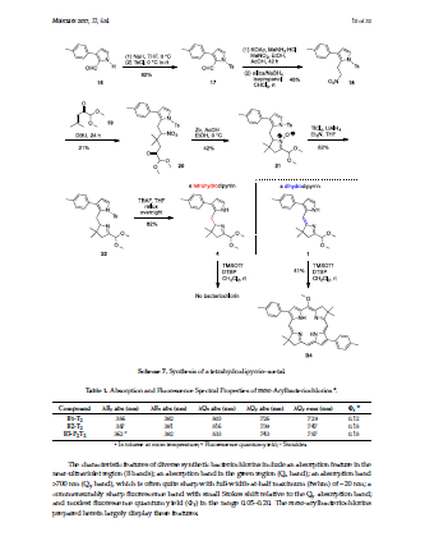
Article
Synthesis and Spectral Properties of meso-Arylbacteriochlorins, Including Insights into Essential Motifs of their Hydrodipyrrin Precursors
Molecules
(2017)
Abstract
Synthetic bacteriochlorins—analogues of bacteriochlorophylls, Nature’s near-infrared absorbers—are attractive for diverse photochemical studies. meso-Arylbacteriochlorins have been prepared by the self-condensation of a dihydrodipyrrin–carbinol or dihydrodipyrrin–acetal following an Eastern-Western (E-W) or Northern-Southern (N-S) joining process. The bacteriochlorins bear a gem-dimethyl group in each pyrroline ring to ensure stability toward oxidation. The two routes differ in the location of the gem-dimethyl group at the respective 3- or 2-position in the dihydrodipyrrin, and the method of synthesis of the dihydrodipyrrin. Treatment of a known 3,3-dimethyldihydrodipyrrin-1-carboxaldehyde with an aryl Grignard reagent afforded the dihydrodipyrrin-1-(aryl)carbinol, and upon subsequent acetylation, the corresponding dihydrodipyrrin-1-methyl acetate (dihydrodipyrrin–acetate). Self-condensation of the dihydrodipyrrin–acetate gave a meso-diarylbacteriochlorin
(E-W route). A 2,2-dimethyl-5-aryldihydrodipyrrin-1-(aryl)carbinol underwent self-condensation to give a trans-A2B2-type meso-tetraarylbacteriochlorin (N-S route). In each case, the aromatization process entails a 2e/2H+ (aerobic) dehydrogenative oxidation following the dihydrodipyrrin self-condensation. Comparison of a tetrahydrodipyrrin–acetal (0%) versus a dihydrodipyrrin–acetal (41%) in bacteriochlorin formation and results with various 1-substituted dihydrodipyrrins revealed the importance of resonance stabilization of the reactive hydrodipyrrin intermediate. Altogether 10 new dihydrodipyrrins and five new bacteriochlorins have been prepared. The bacteriochlorins exhibit characteristic bacteriochlorophyll-like absorption spectra, including a Qy band in the region 726–743 nm.
Keywords
- self-condensation,
- bacteriochlorophyll,
- near-infrared,
- tetrahydrodipyrrin,
- dihydrodipyrrin,
- absorption
Disciplines
Publication Date
April, 2017
DOI
10.3390/molecules22040634
Citation Information
Muthyala Nagarjuna Reddy, Shaofei Zhang, Han-Je Kim, Olga A. Mass, et al.. "Synthesis and Spectral Properties of meso-Arylbacteriochlorins, Including Insights into Essential Motifs of their Hydrodipyrrin Precursors" Molecules Vol. 22 Iss. 4 (2017) p. 634-1 - 634-32 Available at: http://works.bepress.com/olga-mass/3/
Creative Commons license

This work is licensed under a Creative Commons CC_BY International License.
